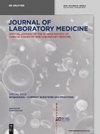Establishment of high-sensitivity cardiac troponin I reference interval for a hospitalized paediatric population under improved selection criteria in the Shandong area
IF 1.8
4区 医学
Q4 MEDICAL LABORATORY TECHNOLOGY
引用次数: 0
Abstract
Objectives This study aimed to evaluate the distribution of plasma troponin I concentration and establish the 99th percentile reference for hs-cTnI in a hospitalized population without a cardiovascular discharge diagnosis from the Shandong area. Methods The hs-cTnI data of anonymous paediatric patients were collected from Qingdao University-Affiliated Yantai Yuhuangding Hospital from 2016 to 2020. Indirect methods were used to calculate the hs-cTnI 99th percentile reference of the whole population and different age groups. Fitting curves and corresponding equations were displayed to determine the relationship between age and hs-cTnI level using the analysis of covariate variance. Results Hs-cTnI plasma levels were highest in the first week of life and declined with age in days. This study found significant differences in the troponin reference intervals for children in different age stratification. The serum hs-cTnI concentration decreased with age in days. In some subgroups, hs-cTnI levels between genders showed a significant difference after the analysis of covariance showed that age was the only predictor of hs-cTnI plasma levels. A non-linear relationship was observed between age and hs-cTnI levels. Thus, curvilinear fitting curve equations for each group were constructed to evaluate the possible relationship between age and hs-cTnI concentration. Conclusions During paediatric period, the highest hs-cTnI concentrations were observed in children aged <1 year, especially those under 7 days. This study presented the 99th percentile cut-offs for different age groups in children aged 0–14 years, which can provide a certain reference value for the clinical diagnosis and treatment of myocardial injury in children.根据改进后的山东地区选择标准,建立住院儿科人群的高敏心肌肌钙蛋白 I 参考区间
目的 本研究旨在评估山东地区无心血管出院诊断的住院人群中血浆肌钙蛋白 I 浓度的分布,并建立 hs-cTnI 的第 99 百分位数参考值。方法 收集青岛大学附属烟台毓璜顶医院 2016 年至 2020 年匿名儿科患者的 hs-cTnI 数据。采用间接法计算全人群和不同年龄组的 hs-cTnI 第 99 百分位数参考值。利用协变量方差分析显示拟合曲线和相应方程,以确定年龄与 hs-cTnI 水平之间的关系。结果 Hs-cTnI 血浆水平在出生后第一周最高,并随着年龄的增长而下降。本研究发现,不同年龄分层儿童的肌钙蛋白参考区间存在明显差异。血清中的 hs-cTnI 浓度随着年龄的增长而下降。协方差分析表明,年龄是预测血浆中 hs-cTnI 水平的唯一因素。年龄与 hs-cTnI 水平之间存在非线性关系。因此,我们构建了各组的曲线拟合方程,以评估年龄与 hs-cTnI 浓度之间可能存在的关系。结论 儿科时期,1 岁儿童的 hs-cTnI 浓度最高,尤其是 7 天以下的儿童。本研究提出了 0-14 岁儿童不同年龄组的第 99 百分位数临界值,可为儿童心肌损伤的临床诊断和治疗提供一定的参考价值。
本文章由计算机程序翻译,如有差异,请以英文原文为准。
求助全文
约1分钟内获得全文
求助全文
来源期刊

Journal of Laboratory Medicine
Mathematics-Discrete Mathematics and Combinatorics
CiteScore
2.50
自引率
0.00%
发文量
39
审稿时长
10 weeks
期刊介绍:
The Journal of Laboratory Medicine (JLM) is a bi-monthly published journal that reports on the latest developments in laboratory medicine. Particular focus is placed on the diagnostic aspects of the clinical laboratory, although technical, regulatory, and educational topics are equally covered. The Journal specializes in the publication of high-standard, competent and timely review articles on clinical, methodological and pathogenic aspects of modern laboratory diagnostics. These reviews are critically reviewed by expert reviewers and JLM’s Associate Editors who are specialists in the various subdisciplines of laboratory medicine. In addition, JLM publishes original research articles, case reports, point/counterpoint articles and letters to the editor, all of which are peer reviewed by at least two experts in the field.
 求助内容:
求助内容: 应助结果提醒方式:
应助结果提醒方式:


